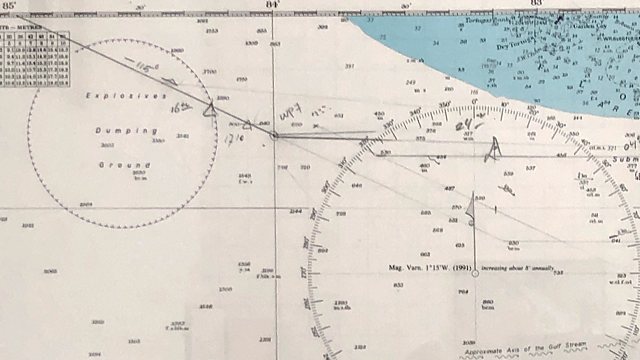Your product roadmap is a compromise
Finding a balance between flexibility and transparency 2020-04-14 #product

- Roadmap compromise ←
- Roadmap detail levels
- Product roadmap triangle
I’ve always loved maps - real maps, maps on paper, in books, framed on the wall, mounted as a globe - all of them. I love their aesthetics and information representation, their practicality and their art. And I really hate it when people draw on maps in pen, even cheap disposable maps. I have to restrain myself to not shout DON’T DRAW ON THE MAP at the hotel receptionist helpfully showing me where to find the best cocktail bar.
Even though I never deface my own maps, I can understand how someone else might mark their destination, to help visualise their route during the journey. You only need to draw the whole planned path on the map in special cases, such as plotting a course at sea (for ships that still use paper maps).

The top-left corner of this maritime chart of Cuba, which hangs on the wall in my kitchen, shows a diagonal line drawn on the map to plot a course through the Straights of Florida, past Key West, on bearing 115 degrees. Of the many details shown in the picture, one brings us back to product roadmaps: the navigator plotted this in pencil.
A roadmap represents compromise. Especially when you draw it in marker pen. Product roadmaps compromise between the clarity of making a twelve-month plan and sticking to it, and the flexibility of taking each day as it comes. In practice, you sometimes need a roadmap that falls between these two extremes, because of how sales and marketing work.
Enterprise sales
Sales people focus on the future, because they focus on the next deal. In business-to-business sales, this future stretches weeks or months ahead. In enterprise sales, doubly so.
Large organisations make decisions slowly, which they address by making decisions in advance, in the form of forecasts, budgets and plans. Choosing to buy your product changes those plans, which takes a long time and lengthens sales cycles. As a result, sales people want to sell the future product, rather than the current product, and so they want to know what this future product can do.
Unfortunately, you can’t predict the future. If you could predict the future, you wouldn’t have to work for a living, in which case you probably wouldn’t be reading this. Selling to enterprise customers means communicating with great care, especially when using product roadmaps.
Marketing campaigns
Marketing campaigns work the way commercial software development used to: fixed dates and big-bang launches. They require a limited compromise: reduce roadmap flexibility in the short-term, for as long as it takes to prepare the campaign. Three things limit the compromise.
- You only need to fix the start of the roadmap - long enough to prepare the campaign.
- You don’t have to include everything on the roadmap in your campaign.
- You can include already-completed work in the ‘release’, trading roadmap uncertainty for delayed customer feedback.
However, these workarounds merely reduce the cost of reduced flexibility.
Further compromises
Opinions vary about whether you can avoid sales and marketing roadmap demand. Meanwhile, organisational trust issues also create roadmap demand. You may need to compromise on flexibility, to achieve better transparency. Just make sure you do it in pencil.

